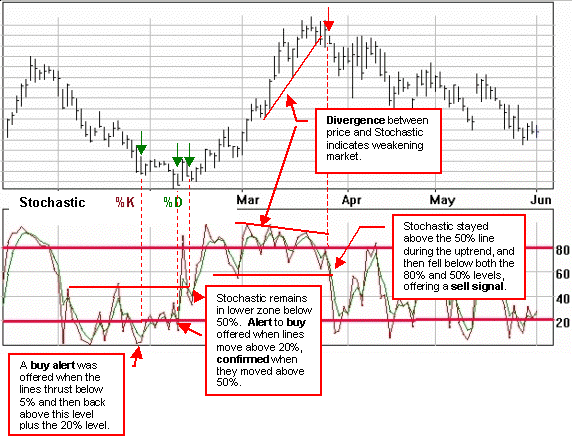Stochastic Oscillator
The stochastic indicator can help determine when a market is overbought or oversold.
Overview
The stochastic indicator is:
- a momentum oscillator that can warn of strength or weakness in the market, often well ahead of the final turning point.
- based on the assumption that when a stock is rising it tends to close near the high and when a stock is falling it tends to close near its lows.

The original stochastic oscillator, developed by Dr. George Lane, is plotted as two lines called %K, a fast line and %D, a slow line.
-
%K line is more sensitive than %D
-
%D line is a moving average of %K.
-
%D line triggers the trading signals.
Although this sounds complex, it is similar to the plotting of moving averages. Think of %K as a fast moving average and %D as a slow moving average. The lines are plotted on a 1 to 100-scale. "Trigger" lines are normally drawn on stochastics charts at the 80% and 20% levels. A signal is generated when these lines are crossed. The zones above and below these two lines can be referred to as the stochastic bands.
Slow Stochastics
The original stochastic is sometimes referred to as the "fast" stochastic to differentiate it from the "slow" stochastic. Some traders feel the fast stochastic %K line is too sensitive and, to improve their analysis, they replace the original %D line with a new slow %K line. The new slow %D line formula is then calculated from the new %K line. The result is a pair of smoothed oscillators that some traders believe provide more accurate signals.
Interpretation
The 80% value is used as an overbought warning signal, and the 20% is used as an oversold warning signal. The signals are most reliable if you wait until the %K and %D lines turn upward below 5% before buying, and the lines turn downward above 95% before selling.
An overbought or oversold level indicates that a market may be vulnerable to a retracement
-
These signals are particularly important with monthly charts. Buying into a market with an overbought %K or selling into one that is oversold may involve above-average risk, particularly if the market is pressing against previous levels of support or resistance.
Signals
The Stochastic Oscillator generates signals in three main ways:
-
Extreme values when the 20% and 80% trigger lines are crossed. Buy when the stochastic falls below 20% and then rises above that level. Sell when the stochastic rises above 80% and then falls below that level.
The pattern of the stochastic is also important; when it stays below 40-50% for a period and then swings above, the market is shifting from overbought and offering a buy signal. And vice versa when it stays above 50-60% for a period of time. -
Crossovers between the %D and %K lines. Buy when the %K line rises above the %D line and sell when the %K line falls below the %D line. Beware of short-term crossovers. The preferred crossover is when the %K line intersects after the peak of the %D line (right-hand crossover). Crossovers often provide choppy signals that need to be filtered through the use of other indicators.
-
Divergences between the stochastic and the underlying price. For example, if prices are making a series of new highs and the stochastic is trending lower, you may have a warning signal of weakness in the market.